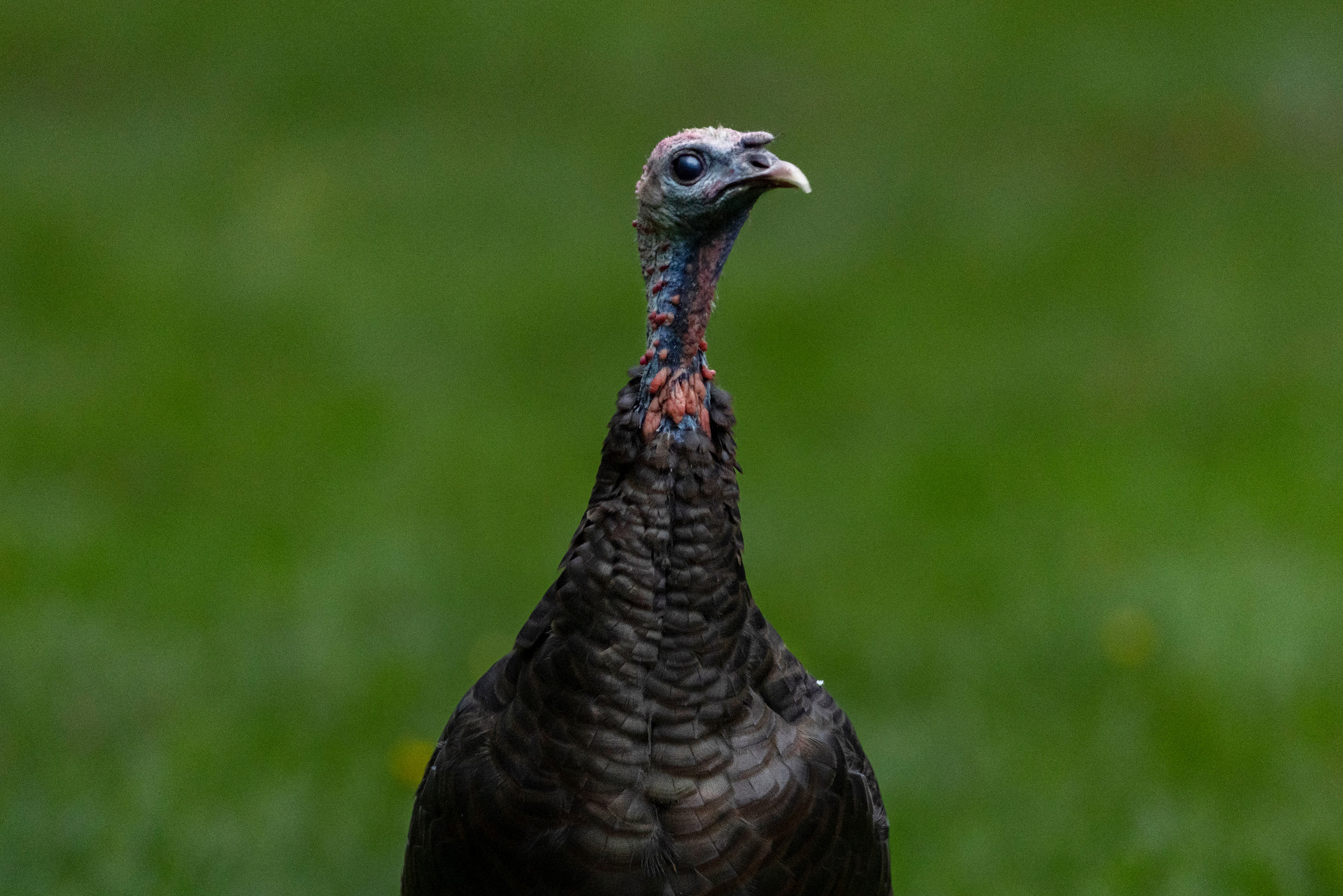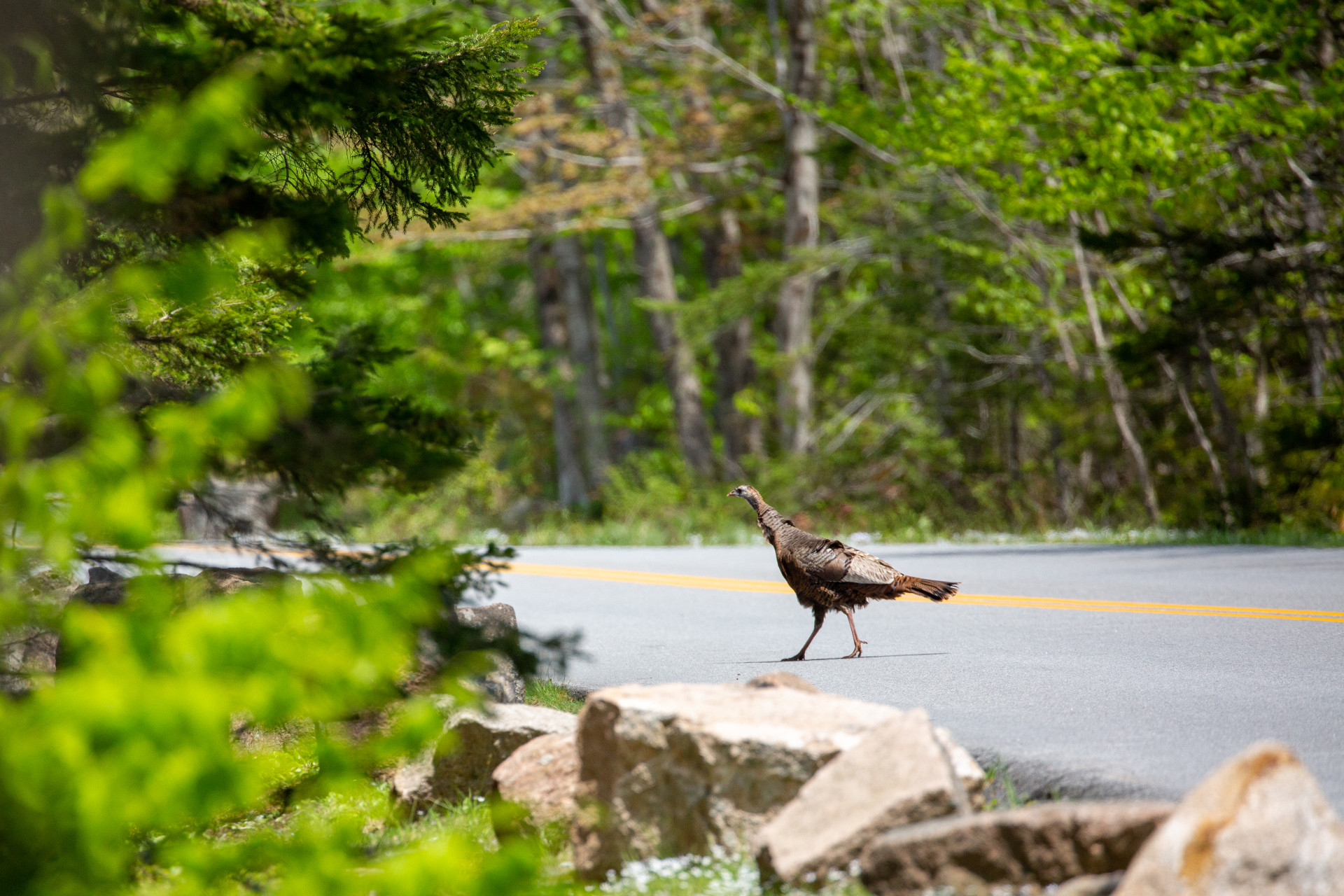A Nod to the Wattle-Wearers of Acadia
Once nearly non-existent in New England, the presence of wild turkeys on Mount Desert Island is a bit of marvel. The birds are pretty cool, too.
November 21st, 2023
Once nearly non-existent in New England, the presence of wild turkeys on Mount Desert Island is a bit of marvel. The birds are pretty cool, too.
November 21st, 2023
Catching a glimpse (or lingering gawk) of the various wildlife in Acadia National Park is a brag-worthy boon for park visitors.
Much of the critter-spotting fanfare is understandably bestowed on the esteemed bald eagle and graceful-yet-skittish white-tailed deer, the dapper loon and flash mobs of cedar waxwings, the head-bobbing seals and squishy-looking sea anemones.
Even the ever-present gulls garner rightful attention (as does the mere hope of spotting a moose, which are rarely spotted on Mount Desert Island).
But we’d like to take a minute to give a wattled nod to another noteworthy Acadia resident: the wild turkey.

A turkey searches for food near the Fabbri picnic area in Acadia National Park. (Photo by Ashley L. Cont/Friends of Acadia)
It’s their easy-going wild turkey strut that first captures our attention. The way they confidently saunter across the road, automobiles be darned, is downright enviable (albeit also discouraged, for their own safety, but wild turkeys don’t tend to take advice from people).
But once we’re slowed to a stop – on the road or on a trail – to give way to a slow-poke parade of wild turkeys, we have the opportunity to appreciate the birds a little better.
More properly known as a flock or, if it’s a group of only males, a posse, the fact that wild turkeys are abundant on Mount Desert Island is a bit of marvel. While they’ve taken to Downeast Maine like they’ve carousing these parts since the age of the dinosaurs, they’re relatively recent arrivals (although they do retain close ties to the dinosaurs: Chickens and turkeys ‘closer to dinosaur ancestors’ than other birds).

A wild turkey crosses the Park Loop Road in Acadia National Park. (Photo by Emma Forthofer/Friends of Acadia)
Up until the 17th century, wild turkeys were abundant in New England, although even then their northern range only extended as far as southern Maine. As Europeans colonized the region, they cut down a lot of trees, which meant wild turkeys were at a loss for habitat and for food. Left with few places to hide and few acorns and chestnuts to eat, their numbers waned. Hunters easily took out the rest. According to a story by Brianna Abbott from National Audubon Society, “By the mid-1850s, New England’s turkeys had all but disappeared.”
“In the 1930s, biologists released hundreds of captive-bred turkeys into the region to try and resuscitate the species,” Abbott writes, “but these domesticated birds couldn’t survive in the wild. In the 1960s, biologists began to explore the idea of trapping Wild Turkeys, primarily from New York, and transporting them for release in New England.”
That effort proved fruitful. Very fruitful. Wild turkeys turned out to be a stand-out conservation success.
Learn more: How Wild Turkeys Took Over New England via Audubon

A hen and her poults, the name for young turkeys, walk alongside the Jordon Pond Carry trail in Acadia National Park. (Photo by Carolyn Rogers/Friends of Acadia)
Their presence isn’t the only impressive thing about wild turkeys. Here are a few others:
Their Heads Are Basically Mood Rings.
“Did you know that turkeys change color depending on their mood? Well, turkey skin, it turns out, can shift from red to blue to white, thanks to bundles of collagen that are interspersed with a dense array of blood vessels. It is this color-shifting characteristic that gives turkeys the name “seven-faced birds” in Japanese and Korean.”
Read more: Turkey Sensors via The California Academy of Sciences
They’re Fast (When They Want To Be).
“Turkeys can clock 18 miles per hour on foot and up to 50 miles per hour in flight.”
Read more: Wild Facts About Wild Turkeys via US Fish and Wildlife
Their Scat Says a Lot.
“You can discern a turkey’s sex from its droppings. Male scat is shaped like the letter J, while a female’s droppings are more spiral-shaped. And the bigger the poop, the older the bird.
Learn more: 10 Fun Facts About the Wild Turkey
Should you care for visuals, the Great Plains Nature Center has you covered.